Super Typhoon Yutu hits Northern Marianas with 180 mph winds
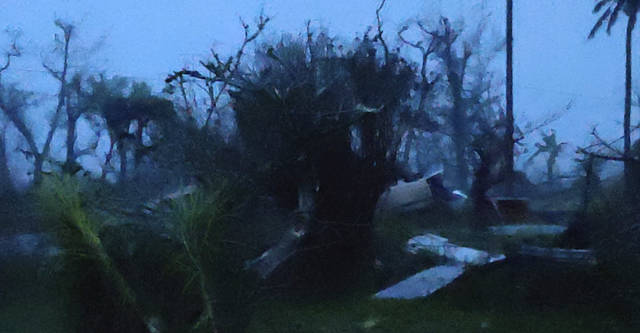
In this photo provided by Glen Hunter, damage from Super Typhoon Yutu is shown outside Hunter’s home in Saipan, Commonwealth of the Northern Mariana Islands, Thursday Oct. 25, 2018. As the powerful storm crossed over the island the walls shook in Hunter’s concrete home, a tin roof over the garage blew away and howling winds terrified his cats. Maximum sustained winds of 180 mph (290 kph) were recorded around the eye of the storm, which passed over Tinian and Saipan early Thursday local time, the National Weather Service said. (Glen Hunter via AP)
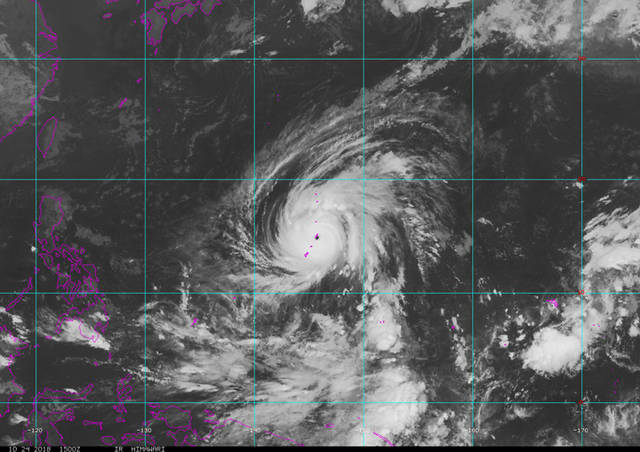
This satellite image provided by the National Oceanic and Atmospheric Administration (NOAA) shows Typhoon Yutu crossing over the U.S. Commonwealth of the Northern Mariana Islands, producing damaging winds and high surf Wednesday, Oct. 24, 2018. The National Weather Service in Honolulu says maximum sustained winds of 180 mph (290 kph) were recorded around the eye of the storm, which passed over Tinian island and Saipan early Thursday morning local time. Waves of 25 to 40 feet (6 to 12 meters) are expected around the eye of the storm. (NOAA via AP)
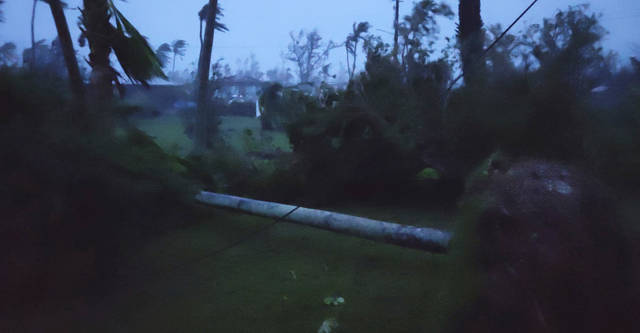
In this photo provided by Glen Hunter, damage from Super Typhoon Yutu is shown outside Hunter’s home in Saipan, Commonwealth of the Northern Mariana Islands, Thursday Oct. 25, 2018. As the powerful storm crossed over the island the walls shook in Hunter’s concrete home, a tin roof over the garage blew away and howling winds terrified his cats. Maximum sustained winds of 180 mph (290 kph) were recorded around the eye of the storm, which passed over Tinian and Saipan early Thursday local time, the National Weather Service said. (Glen Hunter via AP)
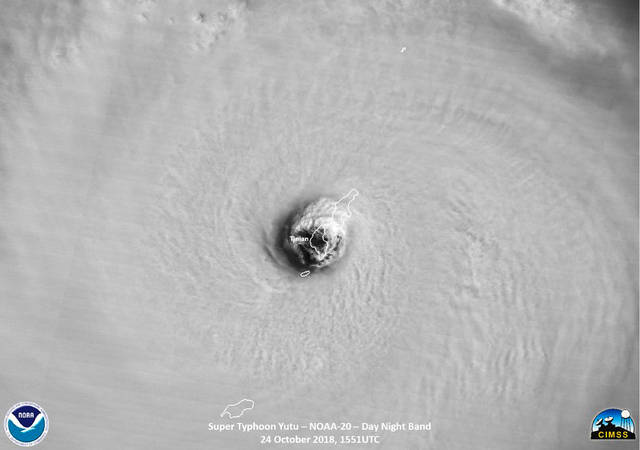
This satellite image provided by the National Oceanic and Atmospheric Administration (NOAA) shows the moment the eye of Super Typhoon Yutu passed directly over Tinian Island, one of three main islands of the U.S. Commonwealth of the Northern Mariana Islands, producing damaging winds and high surf Wednesday, Oct. 24, 2018. The National Weather Service in Honolulu says maximum sustained winds of 180 mph (290 kph) were recorded around the eye of the storm, which passed over Tinian island and Saipan early Thursday morning local time. Waves of 25 to 40 feet (6 to 12 meters) are expected around the eye of the storm. (NOAA via AP)
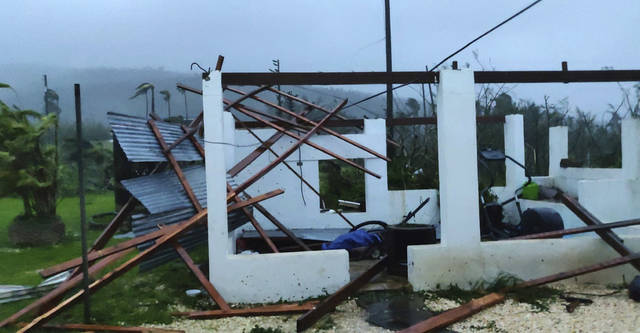
In this photo provided by Glen Hunter, damage from Super Typhoon Yutu is shown outside Hunter’s home in Saipan, Commonwealth of the Northern Mariana Islands, Thursday Oct. 25, 2018. As the powerful storm crossed over the island the walls shook in Hunter’s concrete home, a tin roof over the garage blew away and howling winds terrified his cats. Maximum sustained winds of 180 mph (290 kph) were recorded around the eye of the storm, which passed over Tinian and Saipan early Thursday local time, the National Weather Service said. (Glen Hunter via AP)
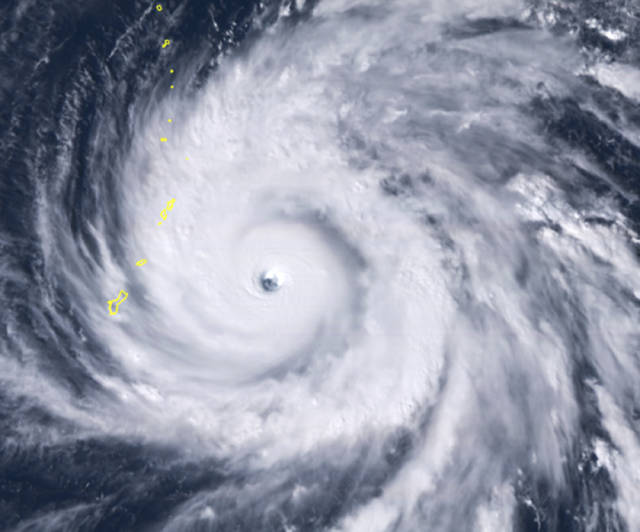
This satellite image provided by the National Oceanic and Atmospheric Administration (NOAA) shows Typhoon Yutu east of Guam Wednesday afternoon, Oct. 24, 2018 local time. The storm crossed over the U.S. Commonwealth of the Northern Mariana Islands, producing damaging winds and high surf. The National Weather Service in Honolulu says maximum sustained winds of 180 mph (290 kph) were recorded around the eye of the storm, which passed over Tinian island and Saipan early Thursday morning local time. Waves of 25 to 40 feet (6 to 12 meters) are expected around the eye of the storm. (NOAA via AP)
HONOLULU — As Super Typhoon Yutu crossed over the U.S. Commonwealth of the Northern Mariana Islands, the walls shook in Glen Hunter’s concrete home, a tin roof over the garage blew away and howling winds terrified his cats.
HONOLULU — As Super Typhoon Yutu crossed over the U.S. Commonwealth of the Northern Mariana Islands, the walls shook in Glen Hunter’s concrete home, a tin roof over the garage blew away and howling winds terrified his cats.
“At its peak, it felt like many trains running constant,” Hunter, of Saipan, wrote in a Facebook message to The Associated Press. “As its peak, the wind was constant and the sound horrifying.”
Maximum sustained winds of 180 mph (290 kph) were recorded around the eye of the storm, which passed over Tinian and Saipan early Thursday local time, the National Weather Service said.
On Wednesday night, the weather service in Guam issued dire warnings of possible destruction of homes and others buildings. “Collapse of some residential structures will put lives at risk,” the update said. “Airborne debris will cause extensive damage.”
The update warned of falling glass from blown-out windows, electricity and water outages for days or weeks after the storm passes and fallen trees isolating residents.
“Gonna be quite a scene when the sun comes up,” Hunter wrote to the AP early Thursday.
It was still quite dark when he peeked outside and saw his neighbor’s house, made of wood and tin, completely gone. A palm tree was uprooted.
Hunter, 45, has lived on Saipan since childhood and is accustomed to strong storms. “We are in typhoon alley,” he wrote, but added this is the worst he’s experienced.
Power went out the previous afternoon and Hunter was bracing for months without electricity or running water. All government offices and schools shut down two days ago. A few gas stations ran out of gas by Tuesday evening, he said.
“We knew it was going to be big,” he said, “but wow.”
The roof flew off the second floor of Del Benson’s Saipan home.
“We didn’t sleep much,” he wrote to the AP in a Facebook message. “I went upstairs and the skylight blew out. Then the roof started to go. We got the kids downstairs.”
Dean Sensui, vice chair for Hawaii on the Western Pacific Regional Fishery Management Council, was in Saipan for a council meeting. He hunkered down in his hotel room, where guests were told to remain indoors because winds were still strong Thursday morning.
“From around midnight the wind could be heard whipping by,” he said in a Facebook message. “Down at the restaurant it sounded like a Hollywood soundtrack with the intense rain and howling wind.”
Because he’s in a solid hotel, it wasn’t as scary as living through Hurricane Iniki in 1992, which left the Hawaiian island of Kauai badly damaged, he said. “The fact that we still have Internet access proves how solid their infrastructure is,” he said. “Hawaii and others should study the Marianas to understand how to design and build communication grids that can withstand a storm.”
Meteorologist Matthew Foster in Honolulu said Yutu is moving quickly enough that the main concern will be the strong winds, not huge amounts of rain that have been associated with other recent hurricanes.
“It’s a very powerful storm,” Foster said. “It’s going to be more of a wind damage threat versus rain.”
A super typhoon would be the equivalent of a category 4 or 5 hurricane.
The Northern Marianas are about 3,800 miles (6,115 kilometers) west of Hawaii, and have a population of about 55,000 people.
Waves of 25 to 40 feet (6 to 12 meters) are expected around the eye of the storm and flooding is likely, forecasters said.
A typhoon warning was in effect for Saipan, Tinian and Rota and a tropical storm warning was in place for Guam and other southern islands.

